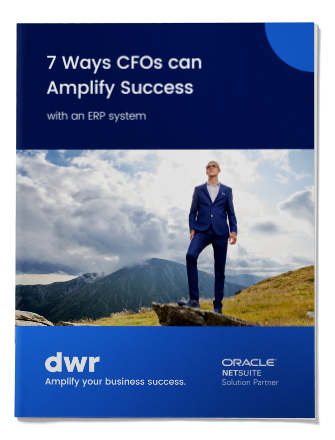We’re in an era of information overload. We’re bombarded with data which can make it difficult to see the forest from the trees. CFO’s, however, act as the compass that leads the business through the right path.
Forward-thinking CFOs are data-driven. They’re often reassessing which data they need to make confident financial decisions. At the same time, they’re also strategically minded. Long-term company growth relies on astute financial strategies, driven by a savvy CFO. That’s because CFOs have broad-reaching responsibility. They’re reviewing technology, evaluating new opportunities and partnerships, looking at attracting and maintaining talent, managing risk, and providing up-to-date information to management teams to support their decisions.
To amplify long-term success, it’s no longer a question of having accurate data, when you need it, right at your fingertips. That’s a given. It’s now also critical for CFOs to have the bandwidth and supporting technology to enact company-wide strategic initiatives.
How does ERP solve CFO challenges?
Companies often start with a core set of applications; a finance application, sales and CRM software, a warehousing system, and sometimes a slew of spreadsheets in between. As the complexity of system infrastructure builds, it results in numerous issues, as covered in this business guide.
 An ERP system has finance at its core, but delivers so much more. ERP provides one back-end platform that brings together all core business functions. Inventory, CRM, sales and marketing, project management, HR, and more are managed within the one business application. The centralised approach works to enhance control, visibility, drive more informed decision-making and streamline operations.
An ERP system has finance at its core, but delivers so much more. ERP provides one back-end platform that brings together all core business functions. Inventory, CRM, sales and marketing, project management, HR, and more are managed within the one business application. The centralised approach works to enhance control, visibility, drive more informed decision-making and streamline operations.
Cloud-based ERP solutions can also connect seamlessly via API to any external system. This creates a future-proofed solution while still acting as your one source of truth.
Read on to see the common problems CFOs encounter with complex, disparate business system frameworks, and how ERP systems solve them.
Data accuracy
Data is key to effective financial operations and the accuracy of that data is critical. Manual data entry and replication of entries between different systems can cause huge knock-on effects. This includes using spreadsheets to manage inventory, manually tracking sales commission data, re-entering customer orders from one system to another, and so on.
Process inconsistencies from one system to the next further compounds the problem. Paperwork stacks up and month-end takes longer each time with more manual transactions to track and reconcile between applications.
A single source of truth
An ERP system brings everything together. It’s one system to issue quotes, take customer orders, manage inventory, process orders through the warehouse, produce invoices, and send out customer orders.
Accounts receivable and payable work with the same data source as sales reps and operations. This central source of information means there’s no manual rekeying or importing of spreadsheet data. Information isn’t becoming splintered with various versions. There’s no duplication of information or hunting down which values are correct.
Even when using additional systems for specific business purposes, all data can be synchronised into an ERP system with automated rules and reports that keep information consistent and clean. The whole business works with a single source of truth in which everyone can be confident.
Visibility
Collecting, processing, and analysing data, can be an arduous process when pulling information from an array of sources. The ability to make fast, informed decisions relies on having the right data at your fingertips; seeing what you need to see at a glance. This just isn’t possible when waiting for reports from different departments or spending time pulling things together in spreadsheets.
CFOs also work across the business with various stakeholders. To work effectively with management teams and support a multitude of strategic decisions, a clear view of all business operations is vital. The disconnected data caused by single-use systems can blur the overall company view. Different departments have different sets of information and conflicting versions that can cause confusion. These disjointed visibility can slow down the decision-making processes between stakeholders and begin to create departmental silos.

A clear view across the business
An ERP system gives CFOs and stakeholders the right visibility of operations, business-wide. Accurate, real-time data is referenced within the one system and powers live dashboards, KPI meters and report snapshots, customisable to each role, to keep everyone informed.
In a few clicks, consolidated financial reports can be adjusted to any timeframe and filtered to any criteria. Budget vs actual, AP & AR ageing, P&L, customer average days to pay, and more are all instantly accessible. For CFOs, seeing trends and changes across sales, warehouse operations, and other business areas makes understanding the business position fast and efficient.
Cost control
You can’t control what you can’t see. With so many different systems in the background, it can be time-consuming and resource-intensive to identify opportunities for cost control. The visibility of unscheduled or unexpected costs is also reduced in this structure. The CFO champions strategic cost-saving initiatives, but they can be challenging to enact properly without streamlined monitoring and management.
A consolidated view to improve control
ERP software creates a single view of costs that brings improved control. For example, automated notifications of products sold below cost, over-ordering of stock, or projects that are under-utilising resources are all set up within a single system.
Improved visibility also lessens the financial impact of unexpected changes. Order demand fluctuations and supply delays, for example, are reflected in real-time reporting, empowering you to react quickly and keep costs controlled.
Security
Any network-connected device can be a potential security risk, including desktops, laptops, servers, software applications, and any data transmitted across networks (the largest of which is the internet). Thus, identifying and pinpointing security breaches can be an exhaustive process with disconnected systems in play.
Serious security measures
Cloud-based ERP solutions like NetSuite place heavy importance on data security. Many of these come out of the box with full tracking and audit trails of changes made, system-wide. Additionally, role-based access ensures that users only see what they need to while still providing the correct access to maximise productivity. Further robust ERP system security aspects include advanced encryption, idle disconnection, security certifications, and operational security measures. Read more about how NetSuite delivers enterprise-level security.
Financial forecasting
 CFOs need to have confidence in sales and revenue forecasts, particularly when dealing with business and market uncertainty. Without confidence in the accuracy of data, forecasts end up relying on a certain amount of guesswork. Disparate systems don’t provide the combined real-time data needed to model impacts of business decisions under rapidly changing conditions. In this scenario, the business is more exposed to greater risk. Contingency planning and minimisation of business disruption are also managed in response to external events rather than proactively.
CFOs need to have confidence in sales and revenue forecasts, particularly when dealing with business and market uncertainty. Without confidence in the accuracy of data, forecasts end up relying on a certain amount of guesswork. Disparate systems don’t provide the combined real-time data needed to model impacts of business decisions under rapidly changing conditions. In this scenario, the business is more exposed to greater risk. Contingency planning and minimisation of business disruption are also managed in response to external events rather than proactively.
Accurate data brings better forecasting
Accuracy of business data is critical, especially for forecasting. Future financial projections rely on past and current data. The information these projections leverage must be correct to produce the right outputs.
The streamlined, connected processes of an ERP platform with its single source of data delivers more accurate, more confident outputs. Strategic business decisions can be made based on live business intelligence to stay on top of trends and changes. Additionally, more exact contingency planning and quick responses to external events keep you in control of critical financial decisions rather than fighting fires.
Attracting and retaining talent
Systems can be a source of frustration for many employees. They can cause miscommunications when speaking in varying terminologies between applications. Staff spend time requesting and chasing reports from other departments – and that static data is often outdated by the time it’s received. These minor quibbles add up over time and eventually create business silos and process complexities that strain human resources. Additionally, the time and effort spent training employees in multiple systems can drive up onboarding costs.
An ERP for better communication
An ERP system provides a central system that everyone knows how to use. Best-practice processes are set up during implementation to keep everyone on the same page. Onboarding becomes a more streamlined process with help always at hand throughout the business. Staff speak the same language when it comes to understanding the system, and company-wide operations become more efficient. This all works together to set the business up for rapid scaling as it grows.
NetSuite can also be a draw-card to attract talent. The platform has been named a leader, four years in a row, in the Gartner Magic Quadrant for Cloud Core Financial Management Suites for Midsize, Large and Global Enterprises. Employees can build their experience with a global ERP system that over 26,000 companies use.
Cash flow management
Cash is always king. With disparate systems in the mix, however, knowing and managing your cash position isn’t always efficient. Manual invoicing and reporting on debtors can slow things down significantly. Current and future cash flow can take hours or days to calculate, pulling static data together from several sources.
 Streamline and automate
Streamline and automate
Within an ERP system, sales, debtors, expenses, and your cash position are all visible at a glance. Dashboard reports with live snapshots, KPIs and metrics also give you a clear view of exceptions, trends and changes as they happen. With real-time data at hand, you quickly get a feel for how the business is doing financially and what may need closer management.
An ERP system also streamlines supply chain and inventory management processes. Minimum and maximum stock levels are one example of this. Automated triggers and alerts inventory at optimal levels. These triggers help reduce cash tied up in excess stock and ensure customers receive their products sooner, adding to the customer experience.
Why consider NetSuite as your ERP platform?
Oracle NetSuite has been named a Leader in the 2021 Gartner Magic Quadrant for Cloud Core Financial Management Suites for Midsize, Large and Global Enterprises. After receiving the honour four years in a row, NetSuite is also one of only four vendors in the Leaders Quadrant and is recognised for its completeness of vision and ability to execute.
NetSuite was born in the cloud. Established in 1998, NetSuite is a pioneer of the cloud ERP industry. The NetSuite platform gives CFOs a real-time view of balance sheets, AP & AR ageing, sales data, operational costs, and more. Expenses, HR and payroll, can all be managed within a single system to give a true 360-degree view.
In NetSuite, CFOs gain a tailored view of critical financial data with fully customisable dashboards. KPIs, metrics and reminders keep you updated at a glance, and report snapshots have full drill-down capabilities to view the detail of any data set quickly. And because NetSuite is a cloud-based solution with advanced security features, business information is always at your fingertips, from wherever you are.
The automation features of NetSuite also drive efficiency and cost reductions. All reports can be scheduled to arrive in your email inbox each morning to act as reminders and speed up your workflow. Invoices and debtor reminders can be triggered automatically. End-of-month processing is even sped up with foreign currency transactions revaluation and the ability to close books gradually throughout the month, a practice called continuous close.
NetSuite is also the first and last ERP system your business will ever need. It’s the same system that’s taken countless businesses from startup to global success and is used by over 26,000 companies worldwide. You don’t want to be constantly implementing new software – that all adds up in terms of time and resources. As a cloud-based solution, NetSuite will connect with virtually any other system via API. NetSuite can exchange information with any specific software in your future roadmap and remain your source of truth.
The next step to leap ahead
Modern CFOs have broad responsibility for company performance and are often the true drivers of business transformation. They also stand to gain the most from an effective ERP solution. Aspects of improved data accuracy, risk minimisation, and process automation work to boost profitability, which is vital for any growing business. From real-time visibility across the business to controlling costs and building better forecasting models, the benefits of a cloud ERP solution are just waiting to be realised.
Dealing with the status quo of disconnected, single-use systems and manual processes is often the easier option. But that can leave you without the confidence in your data, the bandwidth, and the right software foundation to enact company-wide strategic initiatives for long-term growth.
CFOs are now in the driver’s seat and can either keep the business at a steady pace or move into the fast lane. They’re the ones helping other business units understand the potential of improving systems and processes – as well as the risk of not investing in the technology to support future growth.
If you want to truly amplify your success, talk to an ERP expert now and take the next step to leap ahead.


















































 An ERP system has finance at its core, but delivers so much more. ERP provides one back-end platform that brings together all core business functions. Inventory, CRM, sales and marketing, project management, HR, and more are managed within the one business application. The centralised approach works to enhance control, visibility, drive more informed decision-making and streamline operations.
An ERP system has finance at its core, but delivers so much more. ERP provides one back-end platform that brings together all core business functions. Inventory, CRM, sales and marketing, project management, HR, and more are managed within the one business application. The centralised approach works to enhance control, visibility, drive more informed decision-making and streamline operations.
 CFOs need to have confidence in sales and revenue forecasts, particularly when dealing with business and market uncertainty. Without confidence in the accuracy of data, forecasts end up relying on a certain amount of guesswork. Disparate systems don’t provide the combined real-time data needed to model impacts of business decisions under rapidly changing conditions. In this scenario, the business is more exposed to greater risk. Contingency planning and minimisation of business disruption are also managed in response to external events rather than proactively.
CFOs need to have confidence in sales and revenue forecasts, particularly when dealing with business and market uncertainty. Without confidence in the accuracy of data, forecasts end up relying on a certain amount of guesswork. Disparate systems don’t provide the combined real-time data needed to model impacts of business decisions under rapidly changing conditions. In this scenario, the business is more exposed to greater risk. Contingency planning and minimisation of business disruption are also managed in response to external events rather than proactively. Streamline and automate
Streamline and automate






